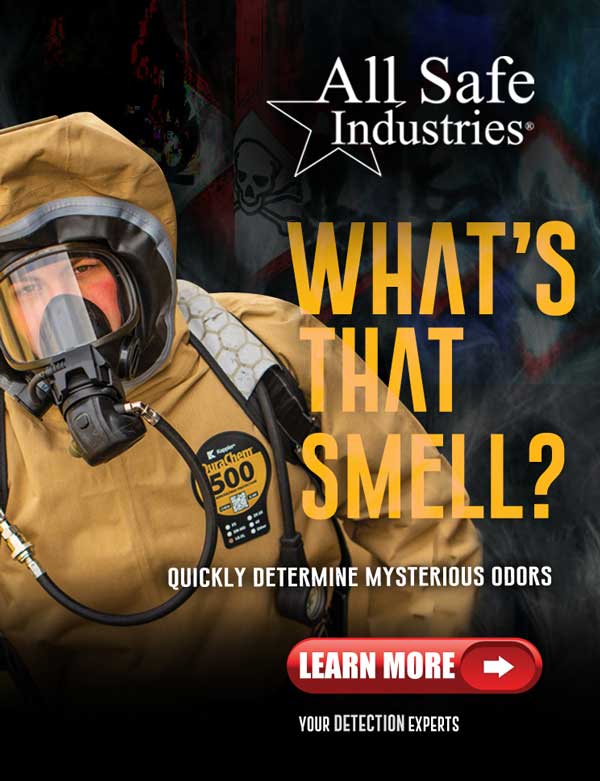By Kevin Ryan
Hazmat responders had to adapt and overcome the biological threat in response to the events of September 11, 2001. More than 20 years later, the words virus, bacteria and toxin are a part of every hazmat tech’s vocabulary and training material. New equipment and procedures allow for a reasonably rapid determination of the threat level involving suspicious substances.
The investigation techniques used are really no different than any other technique used for hazmat. The training and equipment just needed to catch up to the new threat.
Members of the Baltimore City Fire Department Hazmat discovered our suspicious substance procedure could be used as a guide for investigations into incidents beyond substances sent in letters. One such case took place in April 2017. A single engine company was sent to investigate a package that was reported to have exploded or ruptured. The location was a shipping store at the base of a high-rise hotel in downtown Baltimore.
Once on scene, the officer in charge quickly requested for a hazmat tactical to respond. A tactical consists of a battalion chief, two hazmat-trained companies and a hazmat unit.
Also Read: Hazmat Lessons From 3 Recent Suspicious Substance Calls
Initial recon with members of the BCPD Bomb Squad revealed an exploded shipping box that contained a thermos bottle used to keep a biological sample chilled for shipment to a university lab in Florida. The initial recon also quickly ruled out the threat of a secondary explosion.
The package sender also kept a lab at a university in downtown Baltimore. The sender regularly shipped samples in this manner between his labs. The sender was identified, contacted and asked to return to the scene.
The focus of the investigation turned to assess the biological threat as there were two workers in the store who were possibly exposed. The incident commander and hazmat officer on scene formulated a plan to take samples at specific places in the shipping store.
Also Read: Study Looks to Predict Chemical, Airborne Threat Movement
The suspicious substance procedure was used as a guide, yet modified to meet the needs of a different environment. The procedure provided assessment, PPE and detection options to assist the incident commander with his decision making. The occupants were interviewed using the risk assessment sheet. A better understanding of the scene, package and scenario was given to the incident commander and entry team members based on the risk assessment.
The process helped determine that WMD-compliant suits along with a CBRN cartridge were suitable PPE. The bio-detection equipment listed on the entry procedure was used to assess possible samples of the thermos bottle or surrounding surfaces. A protein check, lateral-flow HHA and other options were used. Samples were taken at several points, most notably from the thermos and places where the material could have been dispersed to. The entry team found it difficult to properly assess the scene given the rupture that took place, scattering the package in all directions.
The sender finally returned to the scene to give more information on his package. The sample was bacteria called bdellovibrio that he was studying in his labs. He would use liquid nitrogen to cool the inside of the thermos bottle, then pack the sample in ice and close up the thermos bottle. The sender was studying the bacteria in specific environments and ecosystems. A biologist from US Army Medical Research Institute of Infectious Diseases was consulted about bdellovibrio. She described it as a threat to other bacteria but not to humans.
The most logical explanation for the rupture is that the liquid nitrogen was not completely removed from the bottle before the ice was added. The ice, being at a higher temperature, would warm the liquid nitrogen. The warming process would create pressure inside the closed vessel. The pressure eventually would cause the container to rupture.
The sender had only packaged the sample within an hour of the incident, so it did not take long for the pressure to build inside the container.
The incident really got us to see how versatile the suspicious substance procedure could be. We were able to assess the scene, use the entry procedure to manage the risks and use our findings to determine if the scene was in any way a criminal threat.
As it turned out, the cause was unintentional. Local law enforcement was on scene throughout with federal agencies updated on the incident progress.
The procedure continues to be more diverse than we ever thought. The investigation of fentanyl fits right in with our procedure. We simply added narcotic and fentanyl specific test kits backed by incident response capabilities already in our arsenal. PPE was adjusted as needed to possibly include SCBA instead of CBRN cartridges depending on the scenario.
Original post – Copyright © 2023 HazmatNation.com. Externally linked references may hold their own independent copyright not assumed by HazmatNation



